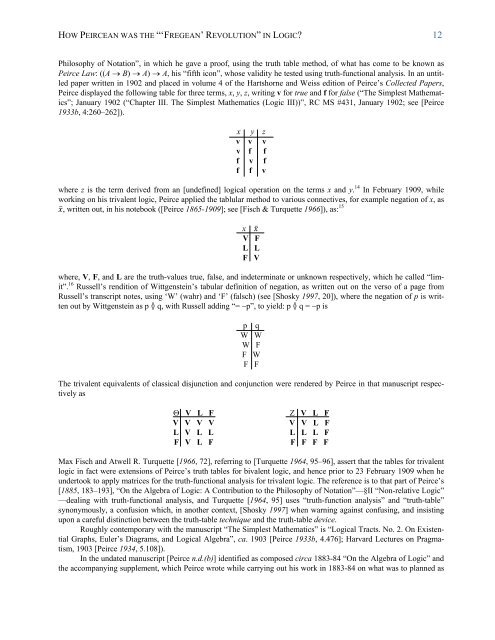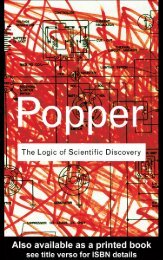Create successful ePaper yourself
Turn your PDF publications into a flip-book with our unique Google optimized e-Paper software.
HOW PEIRCEAN WAS THE “‘FREGEAN’ REVOLUTION” IN LOGIC? 12<br />
Philosophy of Notation”, in which he gave a proof, using the truth table method, of what has come to be known as<br />
Peirce Law: ((A � B) � A) � A, his “fifth icon”, whose validity he tested using truth-functional analysis. In an untitled<br />
paper written in 1902 and placed in volume 4 of the Hartshorne and Weiss edition of Peirce’s Collected Papers,<br />
Peirce displayed the following table for three terms, x, y, z, writing v for true and f for false (“The Simplest Mathematics”;<br />
January 1902 (“Chapter III. The Simplest Mathematics (Logic III))”, RC MS #431, January 1902; see [Peirce<br />
1933b, 4:260–262]).<br />
x y z<br />
v v v<br />
v f f<br />
f v f<br />
f f v<br />
where z is the term derived from an [undefined] logical operation on the terms x and y. 14 In February 1909, while<br />
working on his trivalent logic, Peirce applied the tablular method to various connectives, for example negation of x, as<br />
��, written out, in his notebook ([Peirce 1865-1909]; see [Fisch & Turquette 1966]), as: 15<br />
x ��<br />
V F<br />
L L<br />
F V<br />
where, V, F, and L are the truth-values true, false, and indeterminate or unknown respectively, which he called “limit”.<br />
16 Russell’s rendition of Wittgenstein’s tabular definition of negation, as written out on the verso of a page from<br />
Russell’s transcript notes, using ‘W’ (wahr) and ‘F’ (falsch) (see [Shosky 1997, 20]), where the negation of p is written<br />
out by Wittgenstein as p ≬ q, with Russell adding “= ~p”, to yield: p ≬ q = ~p is<br />
p q<br />
W W<br />
W F<br />
F W<br />
F F<br />
The trivalent equivalents of classical disjunction and conjunction were rendered by Peirce in that manuscript respectively<br />
as<br />
� V L F Z V L F<br />
V V V V V V L F<br />
L V L L L L L F<br />
F V L F F F F F<br />
Max Fisch and Atwell R. Turquette [1966, 72], referring to [Turquette 1964, 95–96], assert that the tables for trivalent<br />
logic in fact were extensions of Peirce’s truth tables for bivalent logic, and hence prior to 23 February 1909 when he<br />
undertook to apply matrices for the truth-functional analysis for trivalent logic. The reference is to that part of Peirce’s<br />
[1885, 183–193], “On the Algebra of Logic: A Contribution to the Philosophy of Notation”—§II “Non-relative Logic”<br />
—dealing with truth-functional analysis, and Turquette [1964, 95] uses “truth-function analysis” and “truth-table”<br />
synonymously, a confusion which, in another context, [Shosky 1997] when warning against confusing, and insisting<br />
upon a careful distinction between the truth-table technique and the truth-table device.<br />
Roughly contemporary with the manuscript “The Simplest Mathematics” is “Logical Tracts. No. 2. On Existential<br />
Graphs, Euler’s Diagrams, and Logical Algebra”, ca. 1903 [Peirce 1933b, 4.476]; Harvard Lectures on Pragmatism,<br />
1903 [Peirce 1934, 5.108]).<br />
In the undated manuscript [Peirce n.d.(b)] identified as composed circa 1883-84 “On the Algebra of Logic” and<br />
the accompanying supplement, which Peirce wrote while carrying out his work in 1883-84 on what was to planned as





